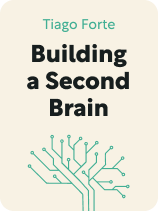

This article is an excerpt from the Shortform book guide to "Building a Second Brain" by Tiago Forte. Shortform has the world's best summaries and analyses of books you should be reading.
Like this article? Sign up for a free trial here.
What is knowledge work? Why are external storage systems important for knowledge work?
Knowledge work is valuable work in today’s society. Scientists, programmers, and more are all considered knowledge workers, and external storage systems can help them be better at their jobs.
Let’s look at why Tiago Forte’s book Building a Second Brain suggests using this system for knowledge work.
Your Brain’s Not Equipped to Effectively Manage Today’s Information
Forte claims that modern humans need an external storage system (ESS)—a digital platform to store all the important ideas, information, and work they encounter—because knowledge, and the ability to do knowledge work, is the most valued asset in today’s society. In Forte’s view, knowledge work involves recalling important pieces of information, making connections between them, and using the insights gained from this process to develop novel ideas or solve problems. Your ability to do knowledge work hinges on how creative and productive you are. Creativity is the ability to make connections between ideas and information. Productivity is the ability to make effective use of your time and creativity to accomplish a goal. The more creative connections you can make, and the faster you can execute on them, the better you’ll be at knowledge work.
However, Forte notes that our ability to do knowledge work is hindered by our brain’s inability to effectively manage today’s information. We have access to an unlimited amount of important information in today’s modern age due to the rapid evolution of technology. However, our brains can’t store and recall this vast quantity of information because they haven’t developed at the same exponential rate. Consequently, we struggle to remember important information when we need it, which hampers our ability to do knowledge work.
A digital external storage system solves this problem by allowing us to store every important idea we encounter in a highly organized system that makes it easy to recall information at any time. This will increase our creativity (ability to draw connections between ideas) and productivity (ability to quickly recall information), which, in turn, will increase our knowledge and ability to do knowledge work.
The History of Knowledge Work
The concept of knowledge work was first popularized in 1959 when management expert Peter Drucker coined the term “knowledge workers” in his book The Landmarks of Tomorrow. As Drucker explains in The Effective Executive, knowledge workers produce results by recalling and sharing important information. Drucker developed this concept because, like Forte, he believed that knowledge and mental labor is the most valuable asset in today’s society. Forte’s description of knowledge work above adds to Drucker’s original concept in a couple of ways. First, Forte expands Drucker’s concept of knowledge work by claiming that creativity, alongside productivity, produces effective knowledge work. Further, while Drucker recommends improving your ability to do knowledge work by strengthening mental skills like effective time management, focus, and the ability to make novel contributions, Forte recommends using an external storage system (what he calls a Second Brain).
Our Biological Tendencies Make Technology Overwhelming and Knowledge Work Hard
In Hyperfocus, Chris Bailey provides context that supports Forte’s claim regarding information overwhelm in the modern world. Bailey explains that our brains aren’t equipped to handle all the information of the technological era—and consequently struggle to do knowledge work—because of the ancient biological limits of our working memory. Our working memory only stores information that’s relevant to the tasks we’re currently working on. Consequently, we can only store a limited quantity of information at a time—far less than the quantity of information that technology provides us with and that we need to do effective knowledge work, as Forte explains.
Bailey elaborates that of the 11 million bits of information our brains process every second in today’s technological era, we can only absorb about 40 of them. Additionally, we can only permanently store and recall between four and seven of those 40 bits of information. Forte’s method to outsource important information into a digital ESS would seemingly cure the pitfalls of our working memory that Bailey discusses. An ESS allows us to permanently save, easily recall, and act on every important piece of information we encounter—even information that’s not currently relevant to us.
How Will an ESS Increase Performance?
According to Forte, there are three primary ways in which using an ESS will increase creativity and productivity, helping us do productive knowledge work:
(1) Having an ESS will allow you to record ideas and information in a concrete, external format that’s easy to comprehend and locate, rather than an abstract format that only exists in your mind and is easy to forget. This will increase your productivity.
(Shortform note: Author and business expert Josh Kaufman agrees that externalizing information—getting it out of your head—improves productivity and makes it much easier to return to ideas later. He adds that writing information down can also help you to approach it from a new perspective. This may be especially useful if you’re storing information on a problem you’re facing or a challenge you’re trying to overcome.)
(2) Being able to review all the ideas and information you’ve ever encountered will allow you to make unique connections between seemingly unrelated concepts, unlocking new levels of creativity.
(Shortform note: You can improve your ability to make connections between seemingly unrelated pieces of information in your ESS by regularly engaging in synectics exercises. One example of a synectics exercise is picking two random objects and trying to devise some kind of connection between them.)
(3) Old ideas and information you’ve recorded are likely to inspire you or be reusable in future projects, which saves time and increases creativity and productivity.
(Shortform note: Beware of reusing your old ideas and writing in academic work, specifically: While doing so may provide the benefits Forte lists, it may also be classed as self-plagiarism, which many academic circles and publications frown upon.)

———End of Preview———
Like what you just read? Read the rest of the world's best book summary and analysis of Tiago Forte's "Building a Second Brain" at Shortform.
Here's what you'll find in our full Building a Second Brain summary:
- Why we get frustrated and overwhelmed in the age of information
- Why modern humans need an external storage system (ESS)
- How to make and organize an ESS to increase creativity and productivity






